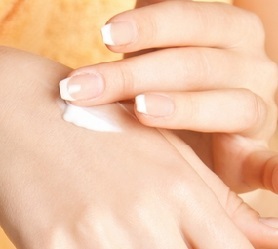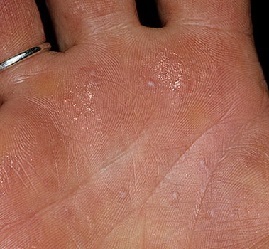 Dyshidrotic eczema is a chronic eczematous dermatitis that affects the skin of the palms and soles and is characterized by eruptions in the form of serous vesicles of small size.
Dyshidrotic eczema is a chronic eczematous dermatitis that affects the skin of the palms and soles and is characterized by eruptions in the form of serous vesicles of small size.
As with other types of eczema, the specific causes and mechanism of development of the dysgidrotic type are not defined, only the role of some provoking factors is known.
Diagnosis of the disease is carried out mainly by eliminating a similar pathology. Treatment of dyshidrotic eczema is carried out with ointments, antihistamines and sedatives, if necessary corticosteroids. Removal of provoking factors plays an important role.
Often there is a dyshidrotic eczema of the hands, on the legs, and also on the fingers of the hands. About the symptoms and treatment, we'll talk in this article.
The causes of dyshidrotic eczema
What it is? Doctors still do not know the exact causes of dyshidrosis. It is assumed that its occurrence is a kind of allergic reaction of the organism, which usually has an autoimmune nature.
The causes of the emergence of the dishydrotic form can be distinguished a huge number, among which the first places are occupied by:
- Stressful situations.
- Mental traumatization.
- Endocrine diseases (including diabetes mellitus and hyperthyroidism).
- Diseases of the digestive tract of various genesis (cholecystitis, pancreatitis, colitis and gastritis).
- Vegetative-vascular dystonia.
- Hereditary factor and genetic predisposition.
- Allergic diseases.
- Chronic gonococcal process in the body.
- Mycosis of the feet.
The disease is accompanied by frequent relapses. The dyshidrotic form of eczema (pompholyx, dyshidrosis) is noted in 20-25% of all cases of occurrence of eczematous processes on the hands.
Symptoms of dyshidrotic eczema
 In the case of dyshidrotic eczema, the symptoms are small vesicles, which eventually form large areas of skin lesions and cause severe itching. After 1-3 weeks the vesicles are opened, forming small erosions.
In the case of dyshidrotic eczema, the symptoms are small vesicles, which eventually form large areas of skin lesions and cause severe itching. After 1-3 weeks the vesicles are opened, forming small erosions.
In the wounds formed, an infection can occur that provokes significant exacerbations during the course of the dyshidrosis. Infectious complications require separate treatment. As a rule, it is associated with the appointment of antibiotics.
It is worth noting that in 80% of patients with dyshidritic eczema the disease affects only one arm, in 10% of patients the symptoms appear only on the legs, and in 10% of cases, the blisters are formed on the arms and legs.
Diagnostics
When diagnosing and confirming dyshidrotic eczema, one external examination and tests may not be enough.
Therefore, apart from them, they exclude such similar signs and manifestations of diseases as, for example:
- Epidermofitiyu stop;
- Dyshidrosis;
- Pustular psoriasis of soles and palms;
- Andrew's pustulous bacterium;
- Chronic atodermatitis Allopo.
When the diagnosis has already been made, it is important to choose the most correct way of treatment in a particular individual case of the disease.
Diet
The basis for the development of eczema is an allergic reaction. Therefore, during the exacerbation of the disease from the diet of the patient should be excluded any products that stimulate the hypertension of the immune system.
These include:
- Citrus;
- Red vegetables;
- Chocolate;
- Nuts;
- Strong tea, coffee;
- Honey and sweets;
- Smoked products;
- A hen;
- A fish;
- Any spicy food;
- Cow's milk;
- Eggs.
Patients are advised to use more sour-milk products, fresh and parboiled vegetables.
What does disgidic eczema look like?
Forecast
Sometimes the signs of dyshidrotic eczema disappear within a few weeks after the start of the course of treatment, without causing any complications. In many cases, however, the treatment takes much longer, and quite often the disease flows into a chronic form and then passes, it reappears. Some patients for years can not get rid of dyshidrosis, despite the use of various medications for this disease.
Affected areas of the skin in any case can not be combed. Damage to the skin can lead to even greater discomfort and even to dangerous bacterial infections.
Treatment of dyshidrotic eczema
There are a lot of ways to treat dyshidrotic eczema, for success individual approach to each patient is important, the effect on the main link of the pathogenetic chain (the cause of the onset).
Before treatment, pathological foci are identified and eliminated, which served as a provoking factor - scars after traumatizing the skin, neuroses, chronic infectious diseases, lesions of internal organs. As well as possible, various external factors that irritate the skin and nervous system of the patient are eliminated.
In the presence of small rashes in the first stage of treatment, aniline dye "fucarcine" very well helps. It is necessary to use various creams containing naphthalan, sulfur, tar, hormonal ointments such as advantan, elocom, powders, talc, starch, zinc, as well as chatterboxes and indifferent pastes. Cool cool wet compresses with tap water or with Burov's solution are good.
Of the medicines used to treat the dyshidrotic eczema of the hands or fingers, the following medicines are used:
- Antihistamines (Suprastin, Tavegil, Claritin and others);
- Hyposensitizing drugs (magnesium sulfate and calcium gluconate);
- Nonsteroidal anti-inflammatory drugs;
- Hormonal anti-inflammatory drugs;
- Complexes of vitamins, primarily vitamins A and E.
- Favorably affect the course of eczema dyshidrotic thalassotherapy (bath with salts of the Dead Sea).
With a severe exacerbation of the disease, courses of corticosteroid therapy, which involves the application of ointment, may be used. The use of corticosteroids inside is prescribed only in exceptional cases and only for a short period of time, as this can cause complications and lead to drug dependence.
Physiotherapy
For treatment of all kinds of specimens are shown such physiotherapy as ultraphonophoresis, UVO of blood, laser therapy, cryotherapy, darsonvalization, magnetotherapy, mud therapy and thalassotherapy. These procedures eliminate skin itching, promote better wound healing, and also have a beneficial effect on the nervous system, replacing sedatives.
An excellent effect gives a combination of physiotherapy with local drugs, for example, electrophoresis and dimexide. In the conditions of sanatorium treatment it is possible to connect several types of physiotherapy at once.
Folk remedies
At home, disgidroticheskuyu eczema can not be cured, but you can try to remove the inflammation and itching with the help of folk methods.
- Take in equal amounts the bark of an oak, a camomile, a yarrow, a turn and do broth for trays. It is recommended to keep your hands in it for 15-20 minutes. To eliminate infection, local antiseptic treatment with ointments having antibacterial properties is performed.
- Take 20 grams of crushed yarrow leaves and add to a glass of boiling water, let it brew for 1 hour. Take 1 cup every day.
- With dyshidrosis, the spots of rashes and redness can be oiled with sea buckthorn oil several times a day.
- Pharmacy tincture of eucalyptus is diluted with water in a proportion of 1: 1, after which the bandage is moistened and applied in the form of appliqués on the hands; the exposure time is 5-10 minutes.
- You can lubricate the affected areas with black currant ointment. 200 grams of butter mixed with powdered blackcurrant branches of black currant. The resulting mixture is placed on a water bath for five minutes.
In general, folk methods of treatment can have a positive effect on the condition of the skin, especially during the chronic course of the disease.

How to choose probiotics for the intestine: a list of drugs.

Effective and inexpensive cough syrups for children and adults.

Modern non-steroidal anti-inflammatory drugs.

Review of tablets from the increased pressure of the new generation.
 Antiviral drugs are inexpensive and effective.
Antiviral drugs are inexpensive and effective.



